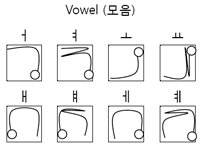Versions of EdgeWrite by Others
Continuous EdgeWrite: Dictionary-Based Disambiguation Instead of Explicit Segmentation by the User
Benoit Martîn, Poika Isokoski, Gregory Karmann, Thomas Rollinger
 |
Other researchers created a version of EdgeWrite that does not require explicit segmentation between
characters, but which uses a dictionary to disambiguate continous multi-character sequences
and turn them into words. This work
culminated in a full paper published at the ACM AVI 2012 conference
held on Capri Island, Italy from May 21-25, 2012.
[ACM]
|
EdgeWrite with Integrated Corner Sequence Help
Benoit Martîn and Poika Isokoski
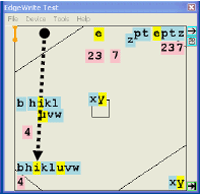 |
Other researchers created a help
system for use with EdgeWrite that improves the learning of character strokes. The system used color coding, letter placement, and
animation to indicate which corners were used to complete which EdgeWrite characters. This work
culminated in a full paper published at the ACM CHI 2008 conference
held in Florence, Italy from April 5-10, 2008.
[ACM]
|
Korean EdgeWrite
Eru Hojin Kim
ELEW
Tue Haste Andersen and Shumin Zhai
 |
Tue Haste Andersen and Shumin Zhai implemented an EdgeWrite variant
called "Edgeless EdgeWrite," or ELEW. ELEW removes the need for strokes to hit absolute
corner locations by using a shape matching gesture recognizer. This allows ELEW
to remove the plastic edges of a physical square and to alter some of the EdgeWrite
letters accordingly. They coupled this version of EdgeWrite with musical feedback to see
if the sounds improved learning of gestures.
[ACM]
|
WatchPad EdgeWrite
Franz Coriand and Gábor Blaskó
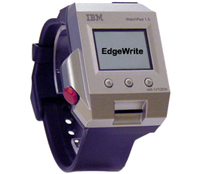 |
Franz Coriand and Gábor Blaskó of Columbia University implemented a
finger-controlled version of EdgeWrite for the IBM/Citizen WatchPad 1.5. This wrist watch runs the Linux
operating system for which Coriand wrote this version of EdgeWrite. The watch is well-suited to
EdgeWrite because it is too small for an on-screen stylus keyboard and already has elevated physical edges
that form a square.
[Video]
|
EdgePad
Ian "Woogal" Ward
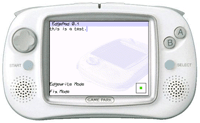 |
Ian "Woogal" Ward implemented a version of EdgeWrite called
EdgePad for the four-way
directional pad on a GP32 game device. The GP32 game device is an open source handheld platform that does not have
a touch screen or stylus, so it was in need of a text entry method for some applications.
[Website]
[Interview]
|
JMEdge
Xavier Richez
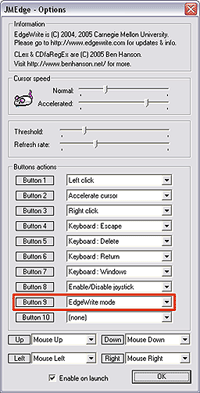 |
Xavier Richez wrote
JMEdge, a Windows application
that runs in the System Tray and translates joystick events into text input. JMEdge is similar to
Joystick EdgeWrite, except that it lacks any visualization of strokes being made,
and it requires a button-press to segment between letters—return to center is not used. JMEdge is part of the
JoyMouse++ system that enables a joystick to emulate the mouse on a desktop computer.
[Website]
|
This page is at: http://depts.washington.edu/ewrite/others.html
Copyright © 2008 Jacob O. Wobbrock
|




